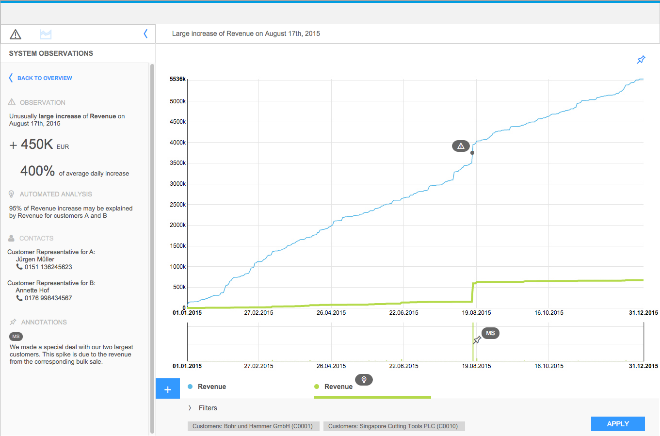4-5 years ago in Microsoft, Cloud business was a small portion of the overall business, but...
 “Talent wins games, but teamwork & intelligence wins championships”, - Michael Jordan, NBA Hall of Fame.
“Talent wins games, but teamwork & intelligence wins championships”, - Michael Jordan, NBA Hall of Fame.
Basketball, like all sports, requires a strong plan before the game starts. But from the moment of the first tip off, the plan needs to be assessed and adjusted. The same is true in business.
Every plan must start with analysis of past results. This can be used as the baseline to determine where the business is going and measure the success in the future. Past results, as everyone knows, are not always indicative of the future.
Machine Learning provides tremendous insight regarding market trends & business drivers. These factors include market propensity, consumer demand, economic factors, weather, & transportation costs. Many companies take these variables into consideration but provide limited or time-consuming analysis. This process limits corporate agility.
IDC learned from a survey in 2018 that 88% of responding organizations were still using spreadsheets as their primary planning vehicle. Most of these organizations were only able to create plans for the entire fiscal year and started the process over again in 9 months for the following year.
Path to Improved Results
For years the Finance organization has heard the hype of analyzing big data. Despite 36% growth in this area, according to Dresner Advisory Services, the Finance department is the laggard for adoption. The leading reason for that has been ease of use or lack thereof.
Imagine if Machine Learning could predict what the most likely numbers should be based on past results. An example of this is “Smart Alerts for Profit & Loss”. This embedded capability identifies anomalies that are not correlated to the expected results and notifies the financial analyst. The analyst has the ability to override if necessary. She/he could also interact with the system verbally. “Show me the variance….” Or “Show me the top 5 factors impacting this result”. In all of these scenarios it is Machine Learning enhancing, not replacing, the financial analyst.
How Does It Work
Intelligent scenarios are embedded in modern cloud applications to provide the most up to date insight by analyzing the actual data being used by the systems of record. This provides users the ability to react to analytic results in context of their business process or workflow.
Intelligent Apps can be developed to modify the embedded Machine Learning scenarios and create insight from the harmonized data from various departments. This insight is then integrated into the corporate planning process.
Some Practical Examples
A luxury manufacturing company in Europe that specializes in windows and skylights, determines the probability of failures in their products. These projections are integrated into their planning process to ensure proper resources, both labor and parts, are in the budget. They have not only realized cost savings from this process. They also have seen improved customer experience.

A leading retailer relies on Machine Learning to understand the business drivers. This company is constantly monitoring its production data as well as store demographics. These factors are analyzed before, during and after each quarter. They cannot afford to wait until the following year to adjust plans. Understanding the propensity of potential customers within a specified radius is a key element of their plan. The faster they can determine the effect of business drivers the more accurately they can adjust the plan. To them planning is an ongoing process not an event.
Airline and Transportation companies have always had to deal with impending events outside of their control that impact their plans. Fuel is the most obvious one. The price of fuel in the future can have a deep impact on profitability and thus the overall business.

Like the manufacturer example, predicting the probability of parts failing could also have a huge impact on costs not to mention revenue. If the plane, truck or ship is not available there will be lost revenue.
Weather is even harder to predict but has impact on all these industries. Manufacturers in the building supply business have improved their forecast accuracy by integrating weather & housing start data into their forecasts. Combining this with analysis of regional stores, has helped them create an actionable plan that improved sales by 10% in the first year.
In Summary
The concepts behind machine learning and advanced analytics are not new. Technology has provided an opportunity to empower everyone in the organization. Machine Learning, Intelligent Robotic Process Automation and Chatbots will provide tremendous efficiency benefits. The real value will come from the improved productivity of the workforce and better business outcomes.
Intelligent Planning combines the power of embedded Machine Learning and analysis tools in the cloud. With these capabilities, today’s business user can accomplish what a team of scientists took months to do in the past in a fraction of the time. The benefit is satisfied customers, happier employees and thus increased profits.
Subscribe to
FP&A Trends Digest

We will regularly update you on the latest trends and developments in FP&A. Take the opportunity to have articles written by finance thought leaders delivered directly to your inbox; watch compelling webinars; connect with like-minded professionals; and become a part of our global community.





